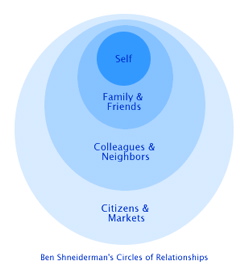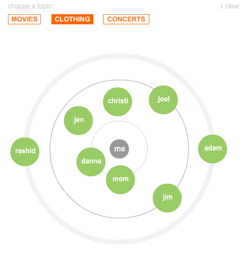Social Networks and Identity Mapping
 It’s a temptation to think when we do social network analysis and generate a seemingly telling network visualisation that we have uncovered a significant truth about a network.
It’s a temptation to think when we do social network analysis and generate a seemingly telling network visualisation that we have uncovered a significant truth about a network.
We’ve had some really good reminders this week about how fragmentary and provisional such visualisations are. It all started with Josh Porter who has been blogging (here and here) on how we form networks that look like concentric circles, where trust dissipates outwards, using Ben Shneiderman’s “Circles of Relationships” visualisation. He got a lot of push back from folks who felt that this visualisation was too static and wasn’t adequate to the true complexity of human relationships.
Then Sarah Cooper published a small flash module that summed up the issue… well, in a flash. Go visit the live module and play with it – but essentially it demonstrates that the same people in your network can command different levels of closeness and trust depending on the topic. Click on a different topic, and the relative trust positions of the players all change.
 This is related to Karen Stephenson’s insight some years ago that we manage different identity networks in parallel, where the same people can have different degrees of closeness to us, depending on whether we are seeking career advice, want to get new perspectives and ideas, or transactional work-related information.
This is related to Karen Stephenson’s insight some years ago that we manage different identity networks in parallel, where the same people can have different degrees of closeness to us, depending on whether we are seeking career advice, want to get new perspectives and ideas, or transactional work-related information.
The lesson? We can’t ever forget that the network visualisations we generate only ever tell us the (current) answer to the single question we asked. They don’t warrant universal statements about the quality and extent of all relationships in the social group. So we need to be clear about which identities we are interested in mapping, and make sure we have mechanisms or questions designed to illuminate each of them. And even when we’ve covered the variant identities, we still need to remember that new contexts can change the relationships. Trust in social networks is like the sea: it ebbs and flows, and is constantly changing.
0 Comment so far
Commenting is not available in this weblog entry.Comment Guidelines: Basic XHTML is allowed (<strong>, <em>, <a>) Line breaks and paragraphs are automatically generated. URLs are automatically converted into links.
